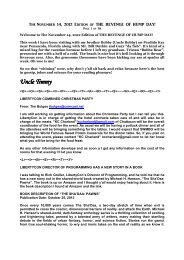Revenge of Hump Day 2012-04-04 - LibertyCon
Revenge of Hump Day 2012-04-04 - LibertyCon
Revenge of Hump Day 2012-04-04 - LibertyCon
- No tags were found...
You also want an ePaper? Increase the reach of your titles
YUMPU automatically turns print PDFs into web optimized ePapers that Google loves.
4. How do we ensure that leaders are trained and fluent in a network perspective?As we discussed much <strong>of</strong> the theoretical, methodological, and empirical aspects <strong>of</strong> networks, thecontributors also discussed the practical aspects. As a whole, the attendees recognize the need tohelp both practitioners and researchers take a “now what” perspective: Once a network analysis<strong>of</strong> any kind is completed, what does an organization, community, or leader do next? Leadershipdevelopment using a network perspective must include strategically building, reshaping, andleveraging networks. We must empower a sense <strong>of</strong> intentionality when incorporating networkthinking, analysis, and development into practice.We agreed that a key aspect <strong>of</strong> leadership development is a network perspective. Increasedperspective provides a starting point for building a network that will help an individual achievepersonal and organizational goals. Individuals need to know where they are in the network, theoverall structure <strong>of</strong> the network, and how their position in the overall structure impacts theirleadership ability and the success <strong>of</strong> their team/organization. Becoming more intentional about theirnetwork requires understanding their network, their role, and the associated outcomes. Therefore,leadership development must provide assessments and reflections to increase network perspectiveand help individuals consider the opportunities and constraints that their network positionprovides. This ability also helps leaders be aware <strong>of</strong>, understand, work within, and manage complexorganizational systems.Leadership development must also help groups <strong>of</strong> individuals, teams, organizations, and communitiesunderstand the structure <strong>of</strong> the network as a whole. This means incorporating network analysis andmapping activities with shared learning opportunities to identify the opportunities and constraintsthe network as a whole has for the collective’s success.Benefits <strong>of</strong> incorporating networks intoleadership development1. Leaders capitalize on their personal and pr<strong>of</strong>essional networks.2. Leaders shape the networks in their communities and organizations.3. Collectives build networks to unleash the potential <strong>of</strong> their communityor organization.12 ©2014 Center for Creative Leadership. All rights reserved.







